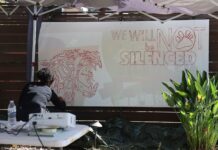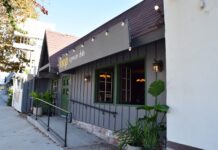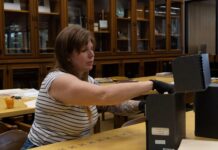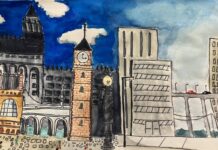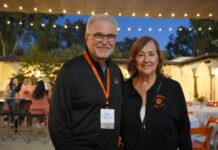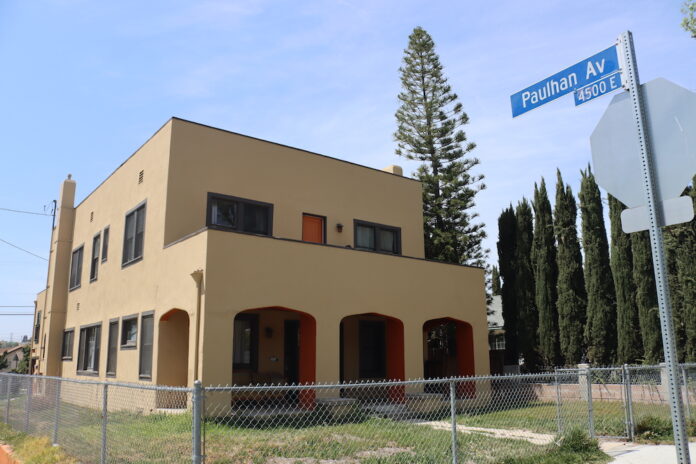
For 15 years, a faded yellow building on Avenue 46 near Occidental’s campus has been known as “Cross House.” The three-unit lot has been rented by private owners to Occidental students, mostly cross country athletes, since 2006. Historically, male cross country runners have lived in the upper unit — “top house” — and female runners have lived in “bottom house.” Men and women runners and their friends have lived in the “back house,” according to multiple current and former cross country athletes. Under the stewardship of the college, the three properties will be renovated and begin a new life as an off-campus dorm for the general student body.
Director of Residential Education, Housing Services and Student Conduct (REHS) Isaiah Thomas said the college purchased the properties to respond to heightened demand for student housing.
“For the past few years, REHS has been in the position of creating more forced triple rooms due to a high number of students matriculating to the college. REHS has also heard feedback from upperclass students that the cost of living off-campus is increasing, which further increases the demand for college housing,” Thomas said via email. “REHS hopes that in the future years we will be able to continue to increase housing spaces to meet the needs of our students.”
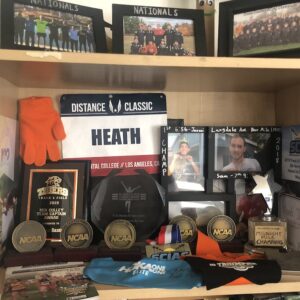
Associate Vice President of Finance Barbara Gillett Valiente, who directs the college’s business office and led the purchase of the properties, added that the purchase made financial sense for the college.
“My involvement was to work with the real estate agent and make sure that the right people saw the property, to run the numbers and make sure it made sense financially, and finally to enter into the purchase agreement with the [Vice President] and [Chief Operating Officer] make the payment for the property,” Gillett Valiente said.
Valiente said the real estate agent contacted the college first about the property, which she said is not unusual.
“Agents frequently contact the College when a nearby property first comes on the market,” Gillett Valiente said. “Five staff members from Facilities, the Business Office and Residential Education conducted several walk-throughs of the units to evaluate their physical condition and whether it would meet the College’s needs. We also had an independent contractor inspect the property. As is the case with all property acquisitions, the College received approval from the Board of Trustees.”
While future residents of the properties on Avenue 46 could be anyone in the student body, Clayton Cheney (junior), a current resident of “top house,” said it is clear from one look at his living room walls that the residents of the past 15 years shared some common interests.
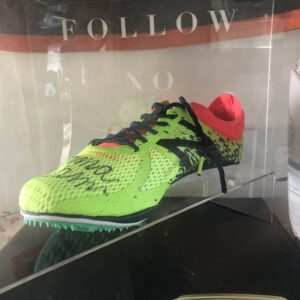
When visitors enter the upper unit, they are greeted by bookshelves draped with cross country medals and running paraphernalia signed by pro athletes, Cheney said.
“All these absolute running nerds have lived here throughout all the years,” Cheney said. “And we’re like, ‘Wow, it’s Emma Coburn,’ and no one has any idea who that is except for [us].”
Cheney explains that Coburn has been the best American steeplechase runner for the past decade. He said Occidental runners eagerly collected her signed race shoes after she competed at one of Occidental’s yearly High Performance Meets for professional athletes. The event, which was called “the most compelling meet in the country” by track blogger Peter Abraham, has provided an opportunity for Occidental runners to watch world champions like Coburn and Mo Farah compete on the college’s Bill Henry Track in Jack Kemp Stadium.
The walls are also adorned with portraits of past residents, but for the most part, these are not the kind of formal photos commonly found in fraternity houses. Instead, mid-race photos of past residents — their faces tightened in concentration and their mouths hanging open, pulling in precious air — cover the wall.
At the end of each year, Cross Country Head Coach Rob Bartlett personally selects his favorite race photo of cross country and track seniors and frames them. The whole team signs the photos before they are placed on the living room wall.
There is, however, one very traditional portrait on the wall — a black and white picture of seven tuxedo- and suit-clad runners. A golden engraved plaque on the aged wooden frame reads “Cross House Founders.”
Kevin Chaves ’08, a founder, said he had dreams of living at a cross country house before even matriculating. He visited his older brother, also a runner, at University of California Davis, where the cross country runners lived together in a big house. Chaves chose Occidental over UC Davis, wanting the small school, Division III experience, but he could never let go of his “dream for the team” — a house of their own.

Going into his junior year, Chaves and team member Robbie Nelson started house hunting. They found some places near campus and developed their pitch for landlords, playing up the quiet and studious reputation of cross country runners.
“We go to bed early, we got morning practice, we got races, you know, we’re athletes, so we’re not going to be crazy partiers,” Chaves said, recalling his pitch. “And what’s more than that, if you let us choose the next people who live in the house from the team, then we can pretty much guarantee that you’ll never have to worry about finding new tenants again.”
The owners of the Avenue 46 properties were convinced, and Chaves and his teammates moved in the Fall of 2006. Chaves said it served the exact purpose he was hoping it would — it became a gathering place for the team and his personal friend group.
“When we came together and made Cross House, we became like a family and it was a communal experience that I think really cemented our friendships,” Chaves said.
Cross country team members from across the years expressed that the house was an important place for team bonding.

Melina Devoney ’17 lived in the bottom house as a junior and senior. She said even as a first year and sophomore, she was at the house all the time.
“It always felt like a second home, even more so than my dorm,” Devoney said.
She remembers her first time going to the house as a first year. Coming from Massachusetts, Devoney said she felt a long way away from home. She texted an older team member, asking if she could come over and do her work there, instead of at the library, and they welcomed her to the house. They all sat together and worked around a table, the upperclassman Cross House residents making snacks for their younger teammates.
“Just having that family feeling around a real dining room table was a memory that stuck in my head,” Devoney said.
Ethan Henes (junior), a current resident of top house, said it was a place where the whole team could get to know each other better.
“It was just a place that anyone could come to and be with cross country and track athletes,” Henes said. “Before big meets, we’d have pasta dinners here.”
Colin Smith ’15 said his first experience of the house was at 13 years old, visiting his older brother Galen, who was a teammate of Chaves. By the time he came to Occidental in the early 2010s, Smith said Cross House felt like a home.
“We never locked the front door and encouraged anybody to visit any time,” Smith said. “What I’ll remember most about the place is that social aspect of it, and all the good times we had there.”
Gabi Wayne (senior) lived in the house for only part of one semester, just before the pandemic. She said the house was also useful because it helped the team follow their strict sleep schedule. Team members needed to wake up at 4 or 5 a.m. on Saturdays to travel to meets and at 6 a.m. one to two days a week for early practices, so it was important that everyone was on the same circadian rhythm. Two non-cross country runners lived in the bottom house with Wayne, and they also observed the communal quiet hours.
“As a freshman, that can be hard, if you’re in the dorms and your roommates are having fun and you can’t,” Wayne said.
Wayne said younger teammates would sometimes come and stay the night on Cross House couches on Friday nights when the on-campus dorms were filled with parties.
The cross house was not always quiet, though, and older team members are forthcoming about the details. There were certainly events and parties, according to multiple former athletes. For many years, the male runners in the top house held an annual party called Dia de Los Dos Muchos, which Chaves said was started by the founders.
Devoney said the party was typically off-limits for members of the women’s team, who she said held a calmer party downstairs.
“And every year, me and one other brave person from the women’s team would try to crash their party because we were like, ‘It’s not fair that only the men get to do it,’” Devoney said. “To my knowledge, no one ever climbed up the back window like we did.”
Devoney said she and a teammate intricately formulated their plan, which consisted of climbing up a rickety off-limits staircase in the back and then through a series of windows. Devoney said they spied through a window and watched the men’s team doing “one of their weird chants and games.” Upon entering the party itself, Devoney said she and her teammate were picked up by the men and carried back downstairs. Dia de los Dos Muchos was technically an initiation party, according to Devony, but she said the team was sensitive and made the party fun for everyone.
The staircase, which the landlords had forbade their tenants from using, was not the only rickety thing in the house. Chaves said one time, the toilet stopped working. When a pond of sewage formed in the backyard, they realized a pipe had broken. Plumbing issues, broken cabinets and other small inconveniences were common issues mentioned about the house, but most residents said that it did not affect their experience of living in the house. The college is now beginning a renovation process, but has not yet decided what renovations will be made, Gillett Valiente said.
Chaves said that he believes there has been a direct correlation between the existence of the house and the success of the team. When Chaves joined the team, he said it was at a low point. There weren’t many people on the team and they never traveled off campus to compete.
“The team made a huge shift back in that time — we went from not having won a conference championship in eight or nine, 10 years to winning three in a row,” Chaves said. “It was right around that time, when we kind of came together and formed this culture where we took things a little bit more seriously and had this sense of belonging to the team, and the sense of tradition and passing things on.”
Chaves said it was a cultural shift that even translated into the team putting more effort into their training. Bartlett was also promoted from assistant coach to head coach around the same time, which also had a big effect on the team’s success, according to Chaves.
Chaves said he has stayed very close with his former teammates.
“They’re the most important people to me in many ways. I mean we’ve supported each other through all these stages of life,” Chaves said.
Now, he said his group of former teammates are supporting each other through early parenthood, constantly messaging in several group chats.
Most team members expressed that, although Cross House is being sold, they are confident that a new one will be established.
“I was sad to hear that Cross House was going on the market, but it’s at least good to hear that Oxy ended up being the buyer,” Smith said.
Henes and Cheney said they are currently in the process of looking for a new house, with the full support of Bartlett. Bartlett has also volunteered to temporarily house the years of memorabilia if a new house is not found quickly enough.
Chaves said he feels confident the tradition will continue on.
“The fact that it’s being sold doesn’t need to be the end of this institution that we created, and I’m not so worried that it will be,” Chaves said. “The same Cross House we established will be ongoing, even if it moves to a different house.”
![]()


